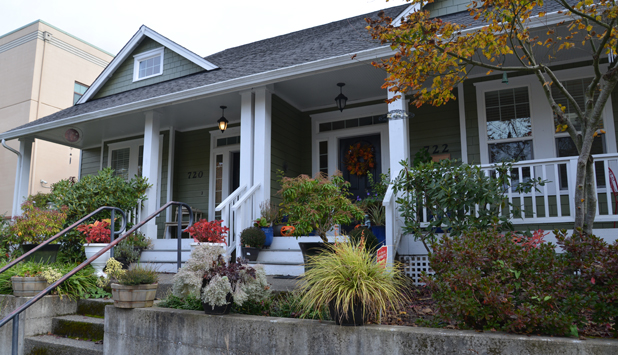Finding ‘Missing Middle’ Housing, Part 1
March 28, 2019
by
Leonard Bauer
Category:
Guest Author
,
Housing

All photos used in this blog post have been provided by the City of Olympia.
Housing affordability is one of the greatest challenges facing many communities in the western U.S. Rising demand outpaces the supply of additional housing units, driving prices steeply upward.
Yet many cities and towns restrict significant portions of their community to the most expensive type of housing—single-family homes—while limiting other housing choices to multi-story apartment buildings in or near busy commercial districts. Traditionally this has been strongly supported by existing homeowners as a way of maintaining ‘neighborhood character’ and property values.
While single-family homes and multi-story apartments remain popular types of housing, there’s something missing in these communities. Most cities and towns prevent (or strongly discourage) the types of housing that are ‘in the middle.’ These include small-scale, multi-unit housing such as duplexes, triplexes, townhouses, backyard cottages (aka, accessory dwelling units or ADUs), and courtyard-style apartments. Allowing and encouraging these ‘missing middle’ housing types can provide more affordable living options, particularly for the growing number of one- and two-person households in our communities, and provide it in a way that is compatible with existing neighborhoods. This approach can also contribute to other community goals, such as accommodating future population increases, increasing walkability, and supporting neighborhood businesses.
 A duplex in the City of Olympia
A duplex in the City of Olympia
Some Washington cities have been examining zoning changes to permit missing middle housing in more neighborhoods. For example, the City of Olympia recently adopted an ordinance to allow many types of missing middle housing in most residential zoning districts. Other cities have better enabled individual types of missing middle housing, such as ADUs. In some cases these proposed changes have generated significant public debate, particularly over possible changes to existing neighborhoods.
Olympia’s Experience
Olympia’s process began in late 2016 when the Olympia City Council established a 16-member citizen workgroup to review its zoning code and development fees to identify ways to better enable missing middle housing throughout the city. The workgroup included a broad range of interests and expertise, and group members brought a thorough knowledge of the local housing market and the community’s neighborhoods.
The workgroup held eight monthly meetings, all of which were open to the public. They identified and discussed dozens of issues, focusing especially on 14 major issues for which they directed city staff to prepare more detailed issue papers. These included requirements for off-street parking, limits on height and setbacks, water and sewer hook-up costs, impact fees, and maximum housing density. They also received input through an open comment portal on the city’s website and at several public open houses. At its final meeting the workgroup reviewed specific recommendations from city staff based on the group’s discussions. The recommendations were to permit a greater variety of housing types in Olympia’s low-density residential zoning districts and to reduce development regulations and fees to more easily allow smaller housing units to be constructed.
Although it had strong policy support in the Olympia Comprehensive Plan, the idea of allowing multi-unit residential buildings in neighborhoods historically dominated by single-family homes caused heated public debate. Organized citizen groups formed on opposite sides of the debate, each conducting intensive public outreach campaigns.
Following nine months of public debate and lengthy discussion by the Olympia Planning Commission, the Olympia City Council unanimously adopted the following changes to the city’s low-density zoning districts:
- ADU requirements were relaxed (height, parking, size, requirement for owner to live on-site, and prohibition of manufactured homes).
- A greater variety of housing types (duplexes, tri- and four-plexes, cottages, and small courtyard apartment buildings) were allowed, especially near major transit routes and commercial districts.
- Added requirements for multi-unit housing (wider lot widths, wider setbacks, and higher off-street parking requirements) were removed.
- Utility and impact fee requirements for smaller housing types (allow for shared utility connections, scale impact fees, and utility hook-up charges for smaller units) were reduced.
While a greater variety of permitted housing types was proposed, the allowed density of the zoning districts was not increased. Also, minimum lot size now increases with the number of units proposed.
The council felt Olympia’s existing development standards adequately addressed a number of issues with no changes. These included design review standards for infill development, low-impact development stormwater measures, regulations of environmentally sensitive areas, and open space and tree protection standards.
 Townhomes in the City of Olympia
Townhomes in the City of Olympia
Olympia’s 2-year experience provides a number of lessons that may be helpful to other cities considering changes to more broadly permit missing middle housing. These lessons will be discussed in Part 2 of this blog series. In the meantime, complete information on Olympia’s planning process is available at its Missing Middle Housing webpage.
Questions? Comments?
If you have questions about this topic or other local government issues, please use our Ask MRSC form or call us at (206) 625-1300 or (800) 933-6772. If you have questions or comments about this blog post, please email the MRSC Insight Editors.
MRSC is a private nonprofit organization serving local governments in Washington State. Eligible government agencies in Washington State may use our free, one-on-one Ask MRSC service to get answers to legal, policy, or financial questions.
